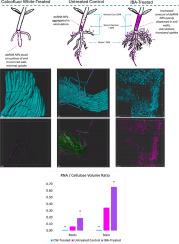Root hairs are essential for dsRNA nanoparticle uptake
IF 7.7
引用次数: 0
Abstract
Nanotechnology offers innovative agricultural solutions, with nanoparticles (NPs) showing promise for targeted delivery of double-stranded RNA (dsRNA). Exogenous dsRNA-mediated RNA interference (RNAi) is a promising gene silencing approach to combat viral pathogens or suppress specific plant endogenous genes without transgenic modification. The effective implementation of RNAi depends on the interactions of NPs with plants, including particle size and charge, uptake, translocation, physical barriers, and physiological and environmental conditions. The difficulties in achieving silencing phenotypes in field conditions remain a barrier to widespread agricultural adoption. Despite advancements, gaps remain in understanding NP uptake mechanisms and transport. Recently, clathrin-mediated endocytosis was found to be a driver of RNA root uptake, which we are also able to confirm with experimental observations. This study focuses on the role of root hairs as key mediators of dsRNA nanoparticle uptake. Inhibition of root hairs reduces RNA uptake, while increased root hair density enhances uptake. Lateral roots can bypass the casparian strip, and higher root hair density leads to increased RNA internalization beyond this barrier. We also propose that caveolar-mediated endocytosis can play a role in cationic polymer complexed-dsRNA NP uptake, and that the integration of RNA into cell walls across the plant allows for a slow release into the cell and sustained silencing phenotype. Validation of the microscopy results was performed by targeting phytoene desaturase (PDS) with dsRNA NPs by irrigation, where bleaching was achieved. Further research is needed to determine how these effects are influenced by plant metabolism, membrane transporters, and cell wall properties.

根毛对dsRNA纳米颗粒的摄取至关重要
纳米技术提供了创新的农业解决方案,纳米颗粒(NPs)显示出靶向递送双链RNA (dsRNA)的希望。外源dsrna介导的RNA干扰(RNAi)是一种很有前途的基因沉默方法,可以在不进行转基因修饰的情况下对抗病毒病原体或抑制特定的植物内源基因。RNAi的有效实施取决于NPs与植物的相互作用,包括粒径和电荷、吸收、转运、物理屏障以及生理和环境条件。在田间条件下实现沉默表型的困难仍然是农业广泛采用的障碍。尽管取得了进展,但在理解NP摄取机制和运输方面仍然存在差距。最近,网格蛋白介导的内吞作用被发现是RNA根摄取的驱动因素,我们也能够通过实验观察来证实这一点。本研究的重点是根毛作为dsRNA纳米颗粒摄取的关键介质的作用。抑制根毛会减少RNA的吸收,而增加根毛密度则会促进RNA的吸收。侧根可以绕过卡斯帕里斯带,更高的根毛密度导致RNA内化增加,超越了这一屏障。我们还提出,小泡介导的内吞作用可以在阳离子聚合物络合的dsrna NP摄取中发挥作用,并且RNA整合到整个植物的细胞壁中允许缓慢释放到细胞中并持续沉默表型。显微镜结果的验证是通过灌溉用dsRNA NPs靶向植物烯去饱和酶(PDS)进行的,其中漂白实现。需要进一步的研究来确定这些作用如何受到植物代谢、膜转运蛋白和细胞壁特性的影响。
本文章由计算机程序翻译,如有差异,请以英文原文为准。
求助全文
约1分钟内获得全文
求助全文

 求助内容:
求助内容: 应助结果提醒方式:
应助结果提醒方式:


